-
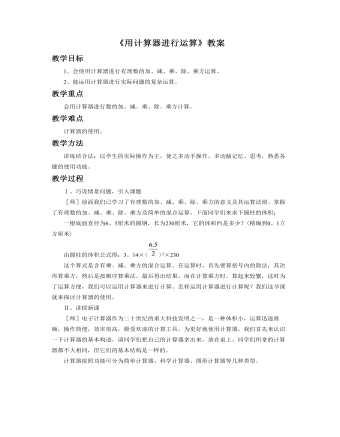
利用计算器进行有理数的计算教案教学设计
计算器的面板是由键盘和显示器组成的。显示器是用来显示输入的数据和计算结果的装置。显示器因计算器的种类不同而不同,有单行显示的,也有双行显示的。在键盘的每个键上,都标明了这个键的功能。我们看键盘上标有的键,是开机键,在开始使用计算器时先要按一下这个键,以接通电源,计算器的电源一般用5号电池或钮扣电池。再看键,是关机键,停止使用计算器时要按一下这个键,来切断计算器的电源,是清除键,按一下这个键,计算器就清除当前显示的数与符号。的功能是完成运算或执行命令。是运算键,按一下这个键,计算器就执行加法运算。
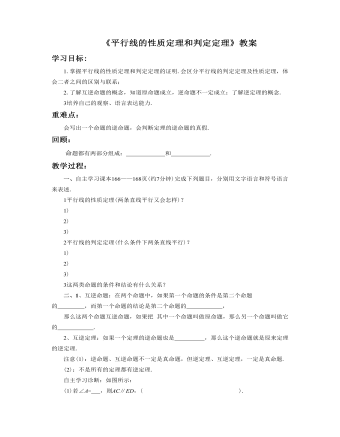
平行线的性质定理和判定定理教案教学设计
1、互逆命题:在两个命题中,如果第一个命题的条件是第二个命题的 ,而第一个命题的结论是第二个命题的 ,那么这两个命题互逆命题,如果把其中一个命题叫做原命题,那么另一个命题叫做它的 .2、互逆定理:如果一个定理的逆命题也是 ,那么这个逆命题就是原来定理的逆定理.注意(1):逆命题、互逆命题不一定是真命题,但逆定理、互逆定理,一定是真命题.(2):不是所有的定理都有逆定理.自主学习诊断:如图所示:(1)若∠A= ,则AC∥ED,( ).(2)若∠EDB= ,则AC∥ED,( ).(3)若∠A+ =1800,则AB∥FD,( ).(4)若∠A+ =1800,则AC∥ED,( ).
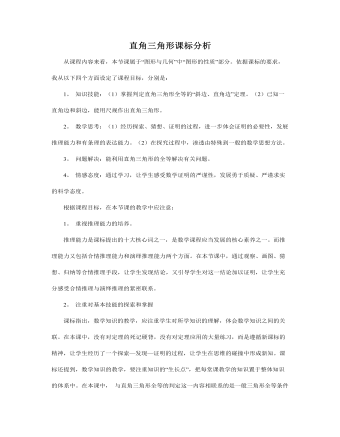
三角形的有关证明 3 直角三角形教案教学设计
从课程内容来看,本节课属于“图形与几何”中“图形的性质”部分。依据课标的要求,我从以下四个方面设定了课程目标,分别是:1。知识技能:(1)掌握判定直角三角形全等的“斜边、直角边”定理。(2)已知一直角边和斜边,能用尺规作出直角三角形。2。数学思考:(1)经历探索、猜想、证明的过程,进一步体会证明的必要性,发展推理能力和有条理的表达能力。(2)在探究过程中,渗透由特殊到一般的数学思想方法。3。问题解决:能利用直角三角形的全等解决有关问题。4。情感态度:通过学习,让学生感受数学证明的严谨性,发展勇于质疑、严谨求实的科学态度。

大班科学教案:常识活动设计:圆形的妙用
1.让幼儿在认识圆的基础上,通过做做、玩玩,让幼儿知道圆形的物体会滚动。2.知道用轮子能省力。3.发展幼儿的发散性思维。【活动准备】1.室外:(1)装有圆形轮胎的小三轮车、四轮车、小推车;(2)装有除圆形以外的各种形状轮胎的小三轮车、四轮车、小推车。2.室内:各种形状的小积木,幼儿人手一套;装有书籍的箱子一只,圆形的轮子两个,小推车一辆,大积木一块,每组一只盒子(装有橡皮泥、硬卡纸、彩色纸、剪刀、牙签、胶水、蜡笔)。【活动过程】一、第一次尝试:滚动圆形和其他形状构成的物体在室外供给幼儿装有圆形轮胎的小三轮车、四轮车、小推车以及装着除圆形以外的各种形状轮胎的小三轮车、四轮车、小推车。教师:“这里有许多车子,我们一起来玩一玩、想一想,哪些车子的轮子会滚动?”二、第二次尝试:圆形的东西会滚动1.在室内供给每位幼儿各种形状的积木玩。①你们的桌子上有什么形状的积木?②请你推动各种积木,你发现了什么?③为什么圆形的积木轻轻一推会滚,而梯形、正方形、长方形、三角形等的积木不会滚动呢?小结:圆形的东西会滚动,因为它没有角。
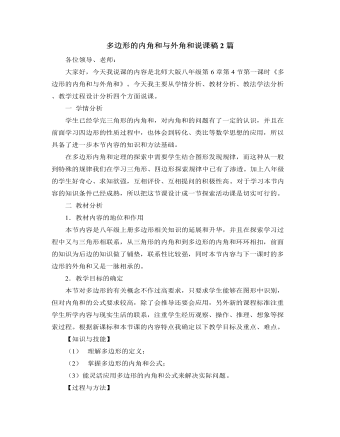
北师大版初中数学八年级下册多边形的内角和与外角和说课稿2篇
a.第127页随堂练习1第(1)题。b.一个多边形的边都相等,这是一个正多边形吗?c.一个多边形的内角都相等,这是一个正多边形吗?d.所以,一个相等,也都相等的多边形才是。(此检测主要是让学说出多边形和正多边形的定义,因为是在三角形、四边形的基础上,定义是一致的,所以不深究。在教材的处理上,把正多边形放在了前面,两个较为简单的概念放在一起,便于学生理解和掌握。)2.各组展示四边形的内角和的计算方法。3.各组展示五边形的内角和的计算方法。(由各组派代表上台板演,其它组补充,真正让学生动起来)4.各组选择前面最优的方法,口述六边形、七边形的内角和的算法。(以此上,学生可以利用对比的方法,选择作出过三角形的一个顶点的对角线的方法,让学生探索发现规律。)5.据此,你们认为n边形的内角和应该怎样计算。(注意n的条件)五、当堂训练。
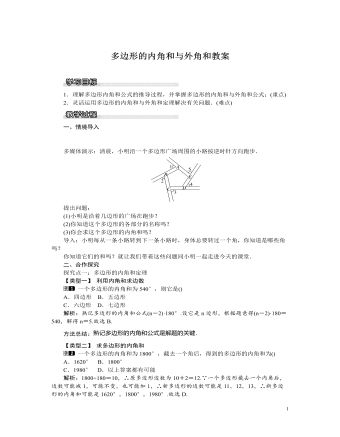
北师大初中八年级数学下册多边形的内角和与外角和教案
方法总结:解题的关键是由题意列出不等式求出这个少算的内角的取值范围.探究点二:多边形的外角和定理【类型一】 已知各相等外角的度数,求多边形的边数正多边形的一个外角等于36°,则该多边形是正()A.八边形 B.九边形C.十边形 D.十一边形解析:正多边形的边数为360°÷36°=10,则这个多边形是正十边形.故选C.方法总结:如果已知正多边形的一个外角,求边数可直接利用外角和除以这个角即可.【类型二】 多边形内角和与外角和的综合运用一个多边形的内角和与外角和的和为540°,则它是()A.五边形 B.四边形C.三角形 D.不能确定解析:设这个多边形的边数为n,则依题意可得(n-2)×180°+360°=540°,解得n=3,∴这个多边形是三角形.故选C.方法总结:熟练掌握多边形的内角和定理及外角和定理,解题的关键是由已知等量关系列出方程从而解决问题.
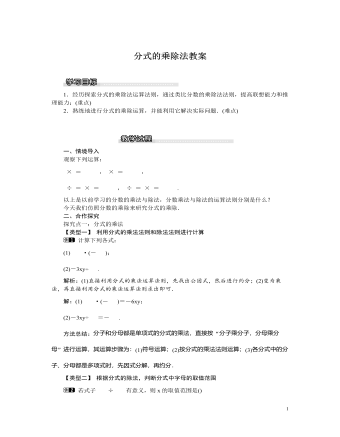
北师大初中八年级数学下册分式的乘除法教案
通常购买同一品种的西瓜时,西瓜的质量越大,花费的钱越多,因此人们希望西瓜瓤占整个西瓜的比例越大越好.假如我们把西瓜都看成球形,并把西瓜瓤的密度看成是均匀的,西瓜的皮厚都是d,已知球的体积公式为V=43πR3(其中R为球的半径),求:(1)西瓜瓤与整个西瓜的体积各是多少?(2)西瓜瓤与整个西瓜的体积比是多少?(3)买大西瓜合算还是买小西瓜合算?解析:(1)根据体积公式求出即可;(2)根据(1)中的结果得出即可;(3)求出两体积的比即可.解:(1)西瓜瓤的体积是43π(R-d)3,整个西瓜的体积是43πR3;(2)西瓜瓤与整个西瓜的体积比是43π(R-d)343πR3=(R-d)3R3;(3)由(2)知,西瓜瓤与整个西瓜的体积比是(R-d)3R3<1,故买大西瓜比买小西瓜合算.方法总结:本题能够根据球的体积,得到两个物体的体积比即为它们的半径的立方比是解此题的关键.
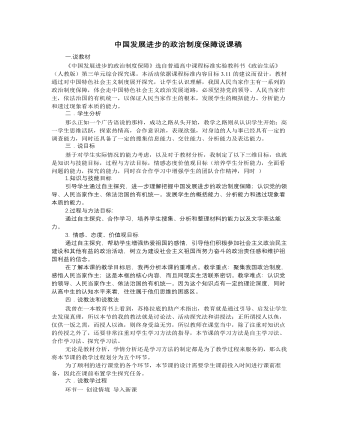
人教版高中政治必修2中国发展进步的政治制度保障说课稿
环节四 课堂总结 巩固知识本节课我采用线索性的板书,整个知识结构一目了然,为了充分发挥学生在课堂的主体地位,我将课堂小结交由学生完成,请学生根据课堂学习的内容,结合我的板书设计来进行小结,以此来帮助教师在第一时间掌握学生学习信息的反馈,同时培养学生归纳分析能力、概括能力。环节五 情景回归,情感升华我的实习指导老师告诉过我们,政治这一门学科要从生活中来到生活去,所以在课堂的最后布置课外作业,以此培养学生对理论的实际运用能力,同时检验他们对知识的真正掌握情况,以此达到情感的升华,本节课,我根据建构主义理论,强调学生是学习的中心,学生是知识意义的主动建构者,是信息加工的主体,要强调学生在课堂中的参与性、以及探究性,不仅让他们懂得知识,更让他们相信知识,并且将知识融入到实践当中去,最终达到知、情、意、行的统一。
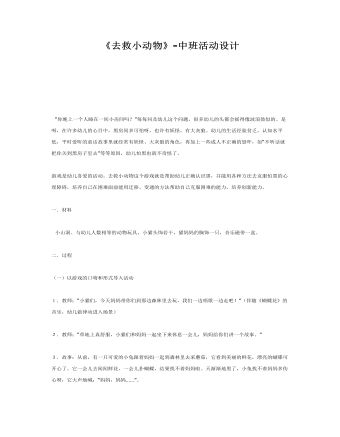
中班主题课件教案:《去救小动物》-中班活动设计
一.材料 小山洞、与幼儿人数相等的动物玩具,小猫头饰若干,猫妈妈的胸饰一只,音乐磁带一盒。二.过程(一)以游戏的口吻和形式导入活动1.教师:“小猫们,今天妈妈带你们到那边森林里去玩,我们一边唱歌一边走吧!”(伴随《蝴蝶花》的音乐,幼儿做律动进入场景)2.教师:“草地上真舒服,小猫们和妈妈一起坐下来休息一会儿,妈妈给你们讲一个故事。”3.故事:从前,有一只可爱的小兔跟着妈妈一起到森林里去采蘑菇,它看到美丽的鲜花,漂亮的蝴碟可开心了。它一会儿去闻闻鲜花,一会儿扑蝴蝶,结果找不着妈妈啦。天渐渐地黑了,小兔找不着妈妈多伤心呀,它大声地喊:“妈妈,妈妈……”。
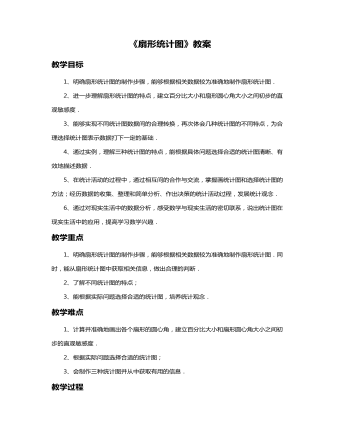
扇形统计图教案教学设计
教学目标1、明确扇形统计图的制作步骤,能够根据相关数据较为准确地制作扇形统计图.2、进一步理解扇形统计图的特点,建立百分比大小和扇形圆心角大小之间初步的直观敏感度.3、能够实现不同统计图数据间的合理转换,再次体会几种统计图的不同特点,为合理选择统计图表示数据打下一定的基础.4、通过实例,理解三种统计图的特点,能根据具体问题选择合适的统计图清晰、有效地描述数据.5、在统计活动的过程中,通过相互间的合作与交流,掌握画统计图和选择统计图的方法;经历数据的收集、整理和简单分析、作出决策的统计活动过程,发展统计观念.6、通过对现实生活中的数据分析,感受数学与现实生活的密切联系,说出统计图在现实生活中的应用,提高学习数学兴趣.
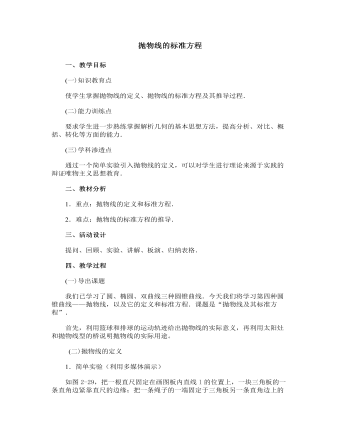
【高教版】中职数学拓展模块:2.3《抛物线》教学设计
一、教学目标(一)知识教育点使学生掌握抛物线的定义、抛物线的标准方程及其推导过程.(二)能力训练点要求学生进一步熟练掌握解析几何的基本思想方法,提高分析、对比、概括、转化等方面的能力.(三)学科渗透点通过一个简单实验引入抛物线的定义,可以对学生进行理论来源于实践的辩证唯物主义思想教育.二、教材分析1.重点:抛物线的定义和标准方程.2.难点:抛物线的标准方程的推导.三、活动设计提问、回顾、实验、讲解、板演、归纳表格.四、教学过程(一)导出课题我们已学习了圆、椭圆、双曲线三种圆锥曲线.今天我们将学习第四种圆锥曲线——抛物线,以及它的定义和标准方程.课题是“抛物线及其标准方程”.首先,利用篮球和排球的运动轨迹给出抛物线的实际意义,再利用太阳灶和抛物线型的桥说明抛物线的实际用途。
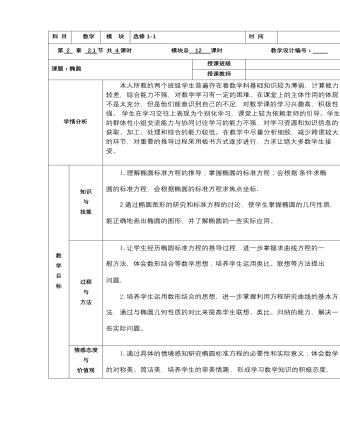
【高教版】中职数学拓展模块:2.1《椭圆》优秀教学设计
本人所教的两个班级学生普遍存在着数学科基础知识较为薄弱,计算能力较差,综合能力不强,对数学学习有一定的困难。在课堂上的主体作用的体现不是太充分,但是他们能意识到自己的不足,对数学课的学习兴趣高,积极性强。 学生在学习交往上表现为个别化学习,课堂上较为依赖老师的引导。学生的群体性小组交流能力与协同讨论学习的能力不强,对学习资源和知识信息的获取、加工、处理和综合的能力较低。在教学中尽量分析细致,减少跨度较大的环节,对重要的推导过程采用板书方式逐步进行,力求让绝大多数学生接受。 1.理解椭圆标准方程的推导;掌握椭圆的标准方程;会根据条件求椭圆的标准方程,会根据椭圆的标准方程求焦点坐标. 2.通过椭圆图形的研究和标准方程的讨论,使学生掌握椭圆的几何性质,能正确地画出椭圆的图形,并了解椭圆的一些实际应用。 1.让学生经历椭圆标准方程的推导过程,进一步掌握求曲线方程的一般方法,体会数形结合等数学思想;培养学生运用类比、联想等方法提出问题. 2.培养学生运用数形结合的思想,进一步掌握利用方程研究曲线的基本方法,通过与椭圆几何性质的对比来提高学生联想、类比、归纳的能力,解决一些实际问题。 1.通过具体的情境感知研究椭圆标准方程的必要性和实际意义;体会数学的对称美、简洁美,培养学生的审美情趣,形成学习数学知识的积极态度. 2.进一步理解并掌握代数知识在解析几何运算中的作用,提高解方程组和计算能力,通过“数”研究“形”,说明“数”与“形”存在矛盾的统一体中,通过“数”的变化研究“形”的本质。帮助学生建立勇于探索创新的精神和克服困难的信心。
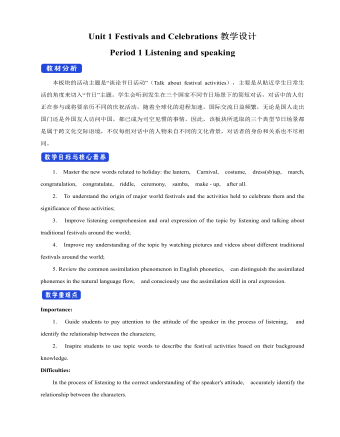
新人教版高中英语必修3Unit 1 Festivals and Celebrations教学设计一
本板块的活动主题是“谈论节日活动”(Talk about festival activities),主要是从贴近学生日常生活的角度来切入“节日”主题。学生会听到发生在三个国家不同节日场景下的简短对话,对话中的人们正在参与或将要亲历不同的庆祝活动。随着全球化的进程加速,国际交流日益频繁,无论是国人走出国门还是外国友人访问中国,都已成为司空见惯的事情。因此,该板块所选取的三个典型节日场景都是属于跨文化交际语境,不仅每组对话中的人物来自不同的文化背景,对话者的身份和关系也不尽相同。1. Master the new words related to holiday: the lantern, Carnival, costume, dress(sb)up, march, congratulation, congratulate, riddle, ceremony, samba, make - up, after all. 2. To understand the origin of major world festivals and the activities held to celebrate them and the significance of these activities;3. Improve listening comprehension and oral expression of the topic by listening and talking about traditional festivals around the world;4. Improve my understanding of the topic by watching pictures and videos about different traditional festivals around the world;5. Review the common assimilation phenomenon in English phonetics, can distinguish the assimilated phonemes in the natural language flow, and consciously use the assimilation skill in oral expression. Importance:1. Guide students to pay attention to the attitude of the speaker in the process of listening, and identify the relationship between the characters;2. Inspire students to use topic words to describe the festival activities based on their background knowledge. Difficulties:In the process of listening to the correct understanding of the speaker's attitude, accurately identify the relationship between the characters.

新人教版高中英语必修3Unit 2 Morals and Virtues教学设计二
Activity 41. Students complete the task of activity 4, then teachers and students check the answers. 2. The teacher organized the students to work together and asked them to use the tables and mind maps sorted out before to retold the important choices in Lin Qiaozhi's life and their resultsStep 5 Language points1. The teacher asks the students to read the text carefully, find out the core words and long and difficult sentences in the text and draw lines, understand the use of vocabulary, and analyze the structure of long and difficult sentences. 2. The teacher explains and summarizes the usage of core vocabulary and asks the students to take notes. 3. The teacher analyzes and explains the long and difficult sentences that the students don't understand, so that the students can understand them better. Step 6 Homework1. Read the text again, in-depth understanding of the text; 2. Master the use of core vocabulary and understand the long and difficult sentences. 3. Complete relevant exercises in the guide plan. 1、通过本节内容学习,学生是否理解和掌握阅读文本中的新词汇的意义与用法;2、通过本节内容学习,学生能否结合文本特点总结林巧稚的人生原则和人格品质特征;3、通过本节内容学习,学生能否针对人生抉择发表自己的看法;能否全面地、客观地、理性地看待问题,进而对道德和人性有更加深入的思考和理解。
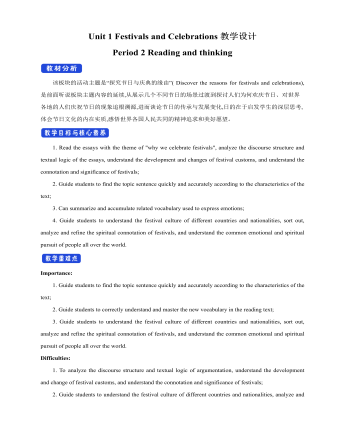
新人教版高中英语必修3Unit 1 Festivals and Celebrations教学设计三
*wide range of origins(= a great number of different origins, many kinds of origins)*It featured a parade and a great feast with music, dancing, and sports. (=A parade and a great feast with music, dancing, and sports were included as important parts of the Egyptian harvest festival.)*.. some traditions may fade away and others may be established.(= Some traditions may disappear gradually, while other new traditions may come into being.)Step 6 Practice(1) Listen and follow the tape.The teacher may remind the students to pay attention to the meaning and usage of the black words in the context, so as to prepare for the completion of the blanks in activity 5 and vocabulary exercises in the exercise book.(2) Students complete the text of activity 5 by themselves.The teacher needs to remind the students to fill in the blanks with the correct form of the vocabulary they have learned in the text.Students exchange their answers with their partners, and then teachers and students check their answers.(3)Finish the Ex in Activity 5 of students’ book.Step 7 Homework1. Read the text again, in-depth understanding of the text;2. Discuss the origin of festivals, the historical changes of related customs, the influence of commercial society on festivals and the connotation and essential meaning of festivals.3. Complete relevant exercises in the guide plan.1、通过本节内容学习,学生是否理解和掌握阅读文本中的新词汇的意义与用法;2、通过本节内容学习,学生能否结合文本特点快速而准确地找到主题句;3、通过本节内容学习,学生能否理清论说文的语篇结构和文本逻辑,了解节日风俗发展与变迁,感悟节日的内涵与意义。

新人教版高中英语必修3Unit 2 Morals and Virtues教学设计四
3.Teachers ask different groups to report the answers to the questions and ask them to try different sentence patterns.The teacher added some sentence patterns for students to refer to when writing.Step 4 Writing taskActivity 51.Write the first draft.Students first review the evaluation criteria in activity 5, and then independently complete the draft according to the outline of activity 4, the answers to the questions listed in the group discussion and report, and the reference sentence pattern.2.Change partners.The teacher guides the students to evaluate their partner's composition according to the checklist of activity 5 and proposes Suggestions for modification.3.Finalize the draft.Based on the peer evaluation, students revise their own compositions and determine the final draft.Finally, through group recommendation, the teacher selects excellent compositions for projection display or reading aloud in class, and gives comments and Suggestions.Step 5 Showing writingActivity 5T call some Ss to share their writing.Step 6 Homework1. Read the passage in this section to better understand the passage.2. Carefully understand the hierarchical structure of the article, and deeply understand the plot of the story according to the causes, process and results;3. Independently complete the relevant exercises in the guide plan.1、通过本节内容学习,学生是否理解和掌握阅读文本中的新词汇的意义与用法;2、通过本节内容学习,学生能否通过人物言行的对比分析道德故事的深层内涵;3、通过本节内容学习,学生能否根据故事的起因、经过和结果来深入理解故事的情节,从而了解文章的层次结构;4、结合现实生活案例发表自己的见解和看法,写一篇观点明确、层次分明的故事评论。

新人教版高中英语必修3Unit 2 Morals and virtues教学设计一
(2) students are divided into groups according to the requirements of activity 3. Each student shares a story of personal experience or hearing-witnessing kindness, and then selects the most touching story in the group and shares it with the whole class. Before the students share the story, the teacher can instruct them to use the words and sentence patterns in the box to express. For example, the words in the box can be classified:Time order: first of all, then, after that, later, finally logical relationship :so, however, although, butTeachers can also appropriately add some transitional language to enrich students' expression:Afterwards, afterwards, at last, in the end, eventuallySpatial order: next to, far from, on the left, in front ofOtherwise, nevertheless, as a result, therefore, furthermore, in addition, as well asSummary: in a word, in short, on the whole, to sum up, in briefStep 8 Homework1. Understand the definition of "moral dilemma" and establish a correct moral view;2. Accumulate vocabulary about attitudes and emotions in listening texts and use them to express your own views;3. Complete relevant exercises in the guide plan.1、通过本节内容学习,学生能否理解理解“道德困境”的定义;2、通过本节内容学习,学生能否通过说话人所表达的内容、说话的语气、语调等来判断其态度和情绪;3、通过本节内容学习,学生能否针对具体的道德困境发表自己的看法和见解,能否掌握听力理训练中的听力策略。

新人教版高中英语必修3Unit 3 Diverse Cultures教学设计三
The price is the same as(the price was)before the war.价格与战前相同。(4)定语从句中的“关系代词+助动词be”可以省略。The ticket(that/which was)booked by his sister has been sent to him.他妹妹订的那张票已送到了他那里。Step 5 PracticeActivity 3(1) Guide students to complete the four activities in the Using Structures part of exercise book, in which activities 1 and 2 focus on ellipsis in dialogue answers, activity 3 focus on signs and headlines, two typical situations where ellipsis is used, and activity 4 focus on ellipsis in diary, an informal style.(2) Combine the examples in the above activities, ask students to summarize the omitted situations in groups, and make their own summary into a poster, and post it on the class wall after class to share with the class.(This step should give full play to the subjectivity of students, and teachers should encourage students to conclude different ellipsis phenomena according to their own understanding, they can conclude according to the different parts omitted in the sentence.)Step 6 Homework1. Understand and master the usages of ellipsis;2. Finish the other exercises in Using structures of Workbook.1、通过本节内容学习,学生是否理解和掌握省略的用法;2、通过本节内容学习,学生能否根据上下文语境或情景恢复句子中省略的成分,体会使用省略的效果;3、通过本节内容学习,学生能否独立完成练习册和导学案中的相关练习。

新人教版高中英语必修3Unit 3 Diverse Cultures教学设计四
该板块的活动主题是“介绍一个有显著文化特征的地方”( Describe a place with distinctive cultural identity)。该板块通过介绍中国城继续聚焦中国文化。本单元主题图呈现的是旧金山中国城的典型景象, Reading and Thinking部分也提到中国城,为该板块作铺垫。介绍中国城的目的主要是体现中国文化与美国多元文化的关系,它是美国多元文化的重要组成部分。中国城也是海外华人的精神家园和传播中国文化的重要窗口,外国人在中国城能近距离体验中国文化。1. Read the text to understand the cultural characteristics of Chinatown in San Francisco and the relationship between Chinese culture and American multiculturalism;2. Through reading, learn to comb the main information of the article, understand the author's writing purpose and writing characteristics;3. Learn to give a comprehensive, accurate, and organized description of the city or town you live in;Learn to revise and evaluate your writing.Importance:1. Guide the students to read the introduction of Chinatown in San Francisco and grasp its writing characteristics;2. Guide students to introduce their city or town in a comprehensive, accurate and organized way;3. Learn to comb the main information of the article, understand the author's writing purpose, and master the core vocabulary.
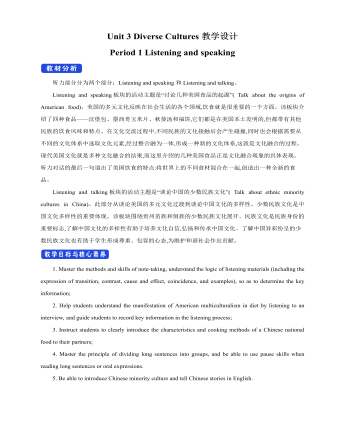
新人教版高中英语必修3Unit 3 Diverse Cultures教学设计一
Activity 81.Grasp the main idea of the listening.Listen to the tape and answer the following questions:Who are the two speakers in the listening? What is their relationship?What is the main idea of the first part of the listening? How about the second part?2.Complete the passage.Ask the students to quickly review the summaries of the two listening materials in activity 2. Then play the recording for the second time.Ask them to complete the passage and fill in the blanks.3.Play the recording again and ask the students to use the structure diagram to comb the information structure in the listening.(While listening, take notes. Capture key information quickly and accurately.)Step 8 Talking Activity 91.Focus on the listening text.Listen to the students and listen to the tape. Let them understand the attitudes of Wu Yue and Justin in the conversation.How does Wu Yue feel about Chinese minority cultures?What does Justin think of the Miao and Dong cultures?How do you know that?2.learn functional items that express concerns.Ask students to focus on the expressions listed in activity. 3.And try to analyze the meaning they convey, including praise (Super!).Agree (Exactly!)"(You're kidding.!)Tell me more about it. Tell me more about it.For example, "Yeah Sure." "Definitely!" "Certainly!" "No kidding!" "No wonder!" and so on.4.Ask the students to have conversations in small groups, acting as Jsim and his friends.Justin shares his travels in Guizhou with friends and his thoughts;Justin's friends should give appropriate feedback, express their interest in relevant information, and ask for information when necessary.In order to enrich the dialogue, teachers can expand and supplement the introduction of Miao, dong, Lusheng and Dong Dage.After the group practice, the teacher can choose several groups of students to show, and let the rest of the students listen carefully, after listening to the best performance of the group, and give at least two reasons.